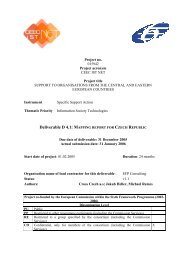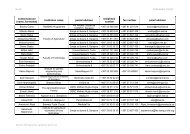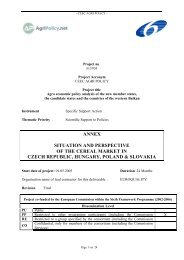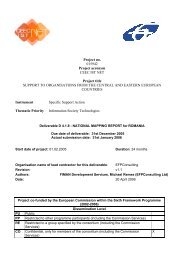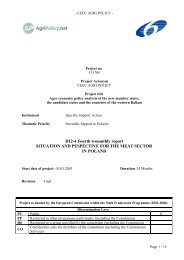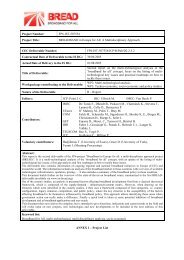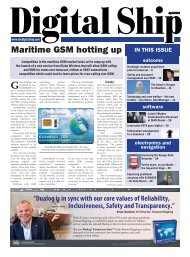Project Number: FP6-IST-507554 Project Title: BROADBAND in ...
Project Number: FP6-IST-507554 Project Title: BROADBAND in ...
Project Number: FP6-IST-507554 Project Title: BROADBAND in ...
Create successful ePaper yourself
Turn your PDF publications into a flip-book with our unique Google optimized e-Paper software.
Page 22 of 319<br />
<strong>FP6</strong>-<strong>IST</strong>-<strong>507554</strong>/JCP/R/Pub/D2.2-3.2<br />
the <strong>in</strong>dustrial growth potentials made possible by a broad diffusion. Arguments aga<strong>in</strong>st have been concerned<br />
primarily with creat<strong>in</strong>g a situation where the mass of users are forced to support the most advanced early<br />
adopters of new technologies, and the dangers and <strong>in</strong>efficiencies of subsidis<strong>in</strong>g technologies that are quickly<br />
made obsolete by new and more powerful technologies. However, some countries have gone beyond the mere<br />
provisions for universal service <strong>in</strong> basic telephony and there is generally open-m<strong>in</strong>dedness <strong>in</strong> relation to the<br />
possible <strong>in</strong>clusion of some sort of universal access provision, e.g. broadband access.<br />
6.5.3 Technology Neutral Regulation<br />
With respect to <strong>in</strong>formation and communication <strong>in</strong>frastructures, there is a general trend <strong>in</strong> policy discourse<br />
towards unit<strong>in</strong>g the regulation of the different <strong>in</strong>frastructures. Most countries have operated with different rules<br />
apply<strong>in</strong>g to fixed networks, mobile networks, and broadcast networks. But with the technical convergence<br />
developments and the <strong>in</strong>creas<strong>in</strong>g possibilities for convey<strong>in</strong>g similar services over different networks, the<br />
foundation for differences <strong>in</strong> regulatory rules are be<strong>in</strong>g questioned. The pr<strong>in</strong>ciple is here that regulation should<br />
not favour use of a particular technology for provision of broadband services.<br />
Many countries, therefore, are seek<strong>in</strong>g to harmonise regulatory frameworks of different communications<br />
<strong>in</strong>frastructures based on the pr<strong>in</strong>ciple of technology neutrality. However, there are some problems attached to<br />
this approach. There are for <strong>in</strong>stance a number of special rules protect<strong>in</strong>g users of fixed telephony, which do not<br />
apply for similar services provided via the Internet. Also, the levels of competition <strong>in</strong> the different <strong>in</strong>frastructure<br />
areas may differ, for <strong>in</strong>stance, with greater competition <strong>in</strong> mobile services than <strong>in</strong> fixed.<br />
6.5.4 Network and media concentration<br />
The balanc<strong>in</strong>g of benefits and problems <strong>in</strong> relation to complementarities and market power is not a new issue.<br />
Public policies have been seek<strong>in</strong>g to strike such balances <strong>in</strong> many areas for a long time, and asymmetric<br />
regulation has been used to <strong>in</strong>crease competition between telecom operators, and <strong>in</strong>cumbent telecom operators<br />
have been forbidden to offer cable TV services and have been requested to divest such activities. On the content<br />
side, many countries have for years had regulations limit<strong>in</strong>g cross media ownership. However, technological<br />
developments <strong>in</strong>clud<strong>in</strong>g digitalisation of different media content, policy developments <strong>in</strong> the direction of<br />
<strong>in</strong>creas<strong>in</strong>g liberalisation and a less str<strong>in</strong>gent view on economic power concentration, and <strong>in</strong>creas<strong>in</strong>g bus<strong>in</strong>ess<br />
<strong>in</strong>ternationalisation lead<strong>in</strong>g to larger corporations and political support for such tendencies, have altered the<br />
former balance po<strong>in</strong>ts between the benefits and problems associated with common ownership of broadcast<strong>in</strong>g<br />
and telecom networks and with media concentration. Network competition needs to be ensured also on a<br />
converg<strong>in</strong>g market for broadband services and there is still a need to ensure plurality <strong>in</strong> media. There is today a<br />
widespread political trend toward loosen<strong>in</strong>g the restrictions on media concentration, <strong>in</strong>clud<strong>in</strong>g cross media<br />
ownership provisions, <strong>in</strong> order to take advantage of the new complementarities between media. However, the<br />
policy issue is still there and just a important as it ever was. New balances have to be struck <strong>in</strong> view of benefits<br />
and drawbacks <strong>in</strong> loosen<strong>in</strong>g and restructur<strong>in</strong>g regulations on media concentration.<br />
6.5.5 Converg<strong>in</strong>g Content Regulation and other content issues<br />
Adaptation of content regulation is crucial for development of broadband. In some areas for <strong>in</strong>stance<br />
broadcast<strong>in</strong>g exist<strong>in</strong>g regulation may pose barriers towards development of converg<strong>in</strong>g services, and users may<br />
be reluctant to use services if consumer protection is <strong>in</strong>adequate. Both issues may hamper service development<br />
and demand, and delay roll-out of a broadband <strong>in</strong>frastructure.<br />
It is an open issue as to the extent regulation <strong>in</strong> the different content areas should converge. In the broadcast<br />
area, many countries have public service provisions of some k<strong>in</strong>d, though they may be very different from one<br />
another. Some broadcasters have responsibilities for provid<strong>in</strong>g services under certa<strong>in</strong> quality obligations but<br />
have, at the same time, a number of privileges <strong>in</strong> terms of, e.g., frequencies for terrestrial transmission. In other<br />
media areas, for <strong>in</strong>stance pr<strong>in</strong>t media, there are no such arrangements. And when content can be used across<br />
different <strong>in</strong>frastructure platforms, the question is what the implications will be for the specific public service<br />
provisions <strong>in</strong> the traditional broadcast<strong>in</strong>g area. It will surely be more difficult to ma<strong>in</strong>ta<strong>in</strong> a central position for<br />
public service broadcasters, but will public service provisions necessarily disappear? Conversely, is it possible<br />
and desirable to extend public service provisions to the Internet web <strong>in</strong> the sense that public service broadcasters<br />
become obliged to develop web pages with a public service type of content?<br />
Another example of a similar question relates to the media responsibility rules for pr<strong>in</strong>t and electronic mass<br />
media. Authors/journalists and editors are <strong>in</strong> most countries responsible for what is pr<strong>in</strong>ted and broadcast.



